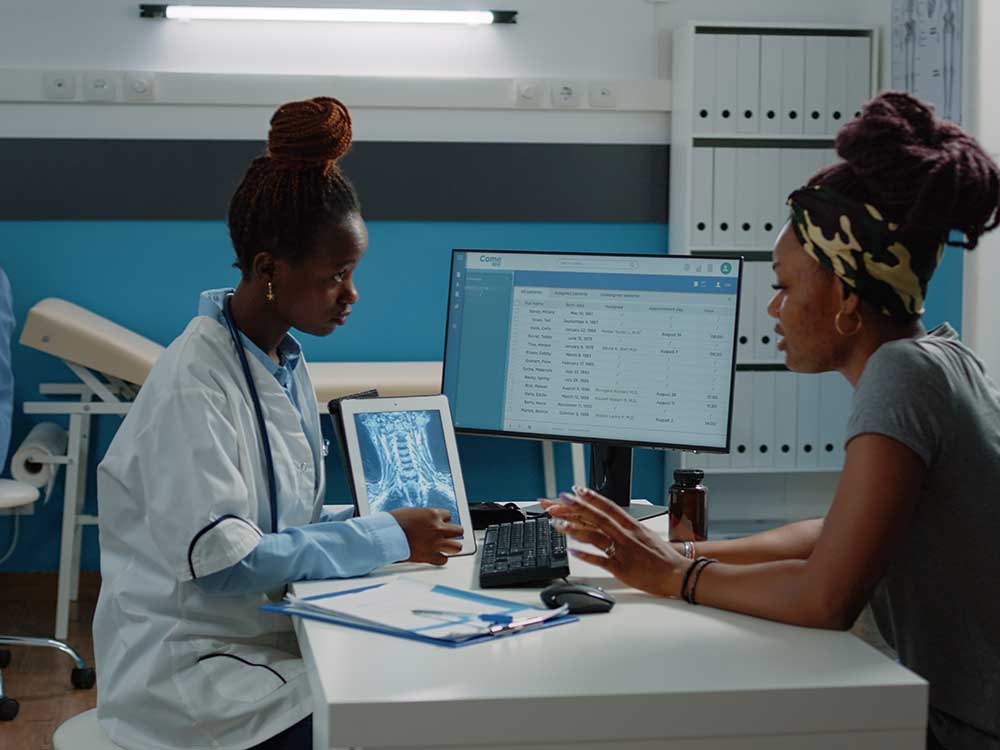Exactly How to Boost Efficiency in Medical Administration with Modern Equipment
Exactly How to Boost Efficiency in Medical Administration with Modern Equipment
Blog Article
Innovations in Medical Management: Exactly How Technology Is Reshaping Health Care Management
The landscape of medical care management is undergoing an extensive change, driven by technological advancements in medical management. Electronic Wellness Records (EHR) have actually come to be the foundation of efficient person data administration, while telemedicine bridges ranges, making healthcare easily accessible to even one of the most remote areas. Artificial intelligence is not simply an advanced principle yet a present-day tool that individualizes patient care and streamlines administrative jobs. As these innovations take spotlight, an important concern arises: just how will these modern technologies further redefine the healthcare experience for both suppliers and clients in the coming years?
Advancement of Electronic Wellness Records
Over the previous couple of years, the development of electronic health and wellness documents (EHRs) has actually substantially transformed the landscape of medical administration. Developed to digitize client records, EHRs have broadened beyond their original range to become integral tools in simplifying medical care procedures, enhancing person care, and improving administrative efficiencies. The change from paper-based systems to EHRs has lowered redundancies, lessened errors, and facilitated smooth information sharing throughout different healthcare carriers, thereby making it possible for extensive and collaborated patient care.
EHRs have actually introduced a paradigm change in health care management by incorporating clinical, management, and financial data, therefore enabling more informed decision-making. The access of real-time person data encourages medical care specialists to make prompt analysis and treatment choices, better boosting person end results. EHRs support the application of evidence-based practices by supplying accessibility to the newest clinical research study and therapy guidelines directly within the scientific process.
The federal motivations and laws have actually sped up EHR fostering, guaranteeing conformity with criteria that protect client privacy and data security. As the medical care sector proceeds to accept digital transformation, EHRs continue to be at the forefront of technology, driving performance and improving the total high quality of health care distribution.
Improvements in Telemedicine
Telemedicine has quickly progressed in recent times, fundamentally changing the means health care services are delivered. This change is largely attributed to technical innovations that have actually increased accessibility to treatment, especially for individuals in remote or underserved areas. Telemedicine systems help with real-time examinations in between clients and health care suppliers, therefore lowering the demand for in-person sees and significantly reducing delay times.
The integration of video clip conferencing, mobile health and wellness applications, and remote monitoring devices has actually boosted the scope of telemedicine. Individuals can currently manage persistent problems with continual monitoring, get timely examinations, and accessibility expert care without geographical restraints. This change has not only better person contentment however has actually additionally optimized healthcare operations and resource allowance.
In addition, telemedicine has actually played a critical role in public health and wellness, specifically throughout pandemics, by decreasing the risk of transmittable condition transmission. Governing developments have further sustained telemedicine's expansion, with numerous countries changing policies to enable broader insurance coverage for virtual check outs.
Regardless of difficulties such as digital proficiency and data protection, the ongoing development of telemedicine promises to maintain its trajectory as a foundation of modern health care administration, using a more available and reliable healthcare shipment design.
Artificial Intelligence in Medical Care
Structure on the technical advancements seen in telemedicine, man-made knowledge read more (AI) is quickly coming to be a transformative force in healthcare management. AI innovations use considerable renovations in effectiveness, accuracy, and decision-making abilities. Among the most engaging applications of AI in healthcare is predictive analytics, which allows health care administrators to anticipate individual needs, improve source allotment, and enhance client end results. By analyzing big datasets, AI formulas can recognize patterns and anticipate prospective wellness situations, making it possible for aggressive treatment.

One more remarkable application remains in individualized medication, where AI helps in customizing therapies to private client profiles by analyzing hereditary, lifestyle, and environmental variables (medical administration). As AI remains to progress, its combination right into medical care administration guarantees to maximize operations, decrease expenses, and inevitably improve the high quality of treatment supplied
Enhancing Information Security Actions
As healthcare organizations increasingly depend on digital systems for handling client information, the requirement for robust information safety procedures has actually grown tremendously. Data violations not just endanger individual personal privacy however also lead to substantial monetary losses and damage to institutional online reputations.
Health care organizations are implementing multi-layered safety frameworks to reduce dangers. File encryption modern technologies guarantee that delicate information stays unattainable to unauthorized users, both throughout transmission and storage space. The fostering of blockchain innovation presents an encouraging method for enhancing data honesty and traceability, giving an unalterable document of all purchases.

Educating team on cybersecurity best techniques is just as vital. Understanding programs equip healthcare personnel with the understanding to identify and report prospective threats, such as phishing attempts. Continue By focusing on information protection, medical administrations can shield client information and maintain count on.
Improving Individual Communication Equipment
While robust data protection steps are basic in safeguarding client details, similarly essential is the improvement of person interaction systems to guarantee reliable medical care delivery. In the evolving landscape of medical care administration, technical technologies are playing a critical function in changing how doctor interact with individuals. Reliable communication systems not just boost person fulfillment but also enhance scientific results by ensuring prompt and exact information exchange.
One of the considerable advancements in this location is the combination of electronic wellness documents (EHR) with individual sites. This assimilation permits clients to access their clinical information safely, routine appointments, and connect with doctor efficiently. Furthermore, the use of telemedicine systems has actually expanded accessibility to health care solutions, especially for those in remote locations or with movement obstacles. These systems promote real-time assessments, decreasing the need for physical visits and allowing continuous care monitoring.
Additionally, artificial intelligence-powered chatbots are being progressively utilized to offer immediate reactions to client inquiries, supplying a seamless communication experience. By leveraging these technical technologies, doctor can foster more personalized person interactions, eventually resulting in improved person involvement and adherence to treatment plans.
Conclusion
Telemedicine boosts healthcare ease of access for remote populaces, while fabricated knowledge automates jobs and individualizes individual involvement. Jointly, these improvements drive performance, minimize expenses, and elevate the high quality of medical care shipment, reshaping business operations in the health care industry.
Report this page